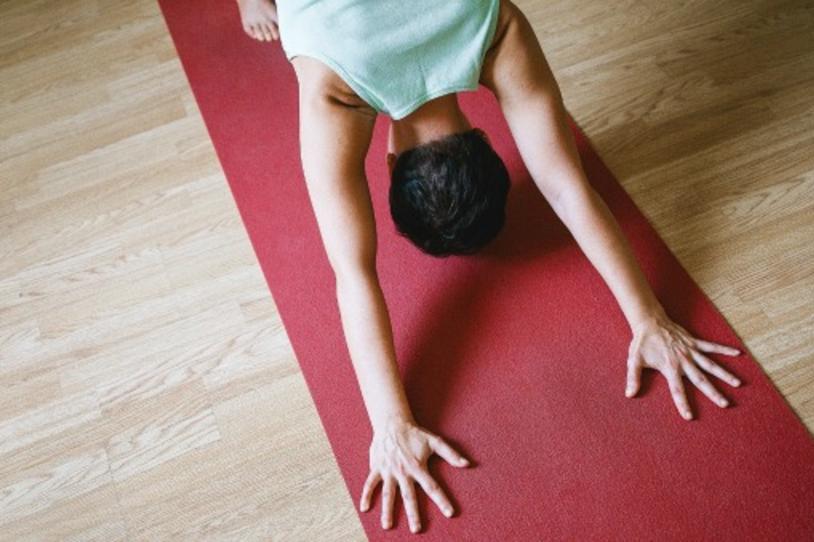
Mindfulness yoga — yoga with meditation and controlled breathing — eases anxiety and depression in people with Parkinson’s, according to a recent study in JAMA Neurology. In a randomized controlled clinical trial in people with mild to moderate Parkinson’s disease (PD), Jojo Kwok, PhD, MPH, RN, a research assistant professor at the University of Hong Kong, and colleagues compared eight weeks of mindfulness yoga to stretching and resistance training. Both exercise programs improved movement symptoms. But mindfulness yoga improved movement symptoms to a greater degree, reduced anxiety and depression, and improved outlook and quality of life.
To learn more about this study and what it means for the many people with PD who experience mood symptoms, we spoke with Sarah Mulukutla, MD, MPH, board-certified neurologist and founder of Mindful Neurology in New York City.
The Michael J. Fox Foundation for Parkinson’s Research (MJFF): Could you tell us more about the study?
Sarah Mulukutla (SM): This was an eight-week trial of once-weekly yoga versus stretching and resistance training in 138 people with mild to moderate Parkinson’s disease, meaning they could walk without a cane or walker and get up and down from the floor on their own.
The yoga protocol in this study was built upon a “mindfulness-based stress reduction” program, which is meditation that involves paying attention to thoughts and breath in a non-judgmental manner. Researchers have studied mindfulness-based stress reduction for its effect on various symptoms — anxiety, depression and pain. One study showed mindfulness is associated with positive brain changes in people with Parkinson’s.
In this study, the researchers added mindfulness and controlled breathing to a traditional yoga practice called Hatha yoga. The stretching and resistance program involved stretches (such as forward bending and hamstring stretches), range of motion activities and body weight exercises (wall squats, side lunges and leg kicks, for example). Both programs included one in-person class each week as well as at-home practices twice a week.
MJFF: What did the researchers find?
SM: The researchers looked at a range of measures: anxiety and depression; movement symptoms and mobility; quality of life (how well a person completes daily functions); and spiritual well-being (how you confront tough situations, such as illness, that can generate negative feelings and emotions).
Both groups’ movement symptoms improved, but for most of these measures, the yoga group outperformed the stretching and resistance training group. The most prominent finding was that anxiety and depression improved only in people who did mindfulness yoga.
MJFF: What does this study add to our current knowledge?
SM: The study showed mindfulness yoga significantly impacted anxiety and depression. These are very common symptoms in people with Parkinson’s, and they can worsen movement symptoms. Anxiety, for example, can bring on a freezing episode. The benefit happened after just six classes (on average, participants attended only six classes) and persisted an additional 12 weeks after completing the program. It’s a well-designed, randomized, controlled trial showing that an intervention such as mindfulness yoga can ease anxiety and depression.
MJFF: Why is this study important for people with Parkinson’s?
SM: It’s uplifting to see that this practice, which has been done for thousands of years, can be adapted for Parkinson’s and have a positive impact. It’s also motivating, especially for people who have apathy or mood changes and may feel there’s nothing to do, to know there is something you can do.
The study also seems to show that mindfulness, or awareness of the mind-body connection, is important and helpful for people with Parkinson’s, since it was a core feature of the yoga program. You can bring mindfulness into your daily activities, hobbies and exercises simply by paying attention to your breath, body and movement.
MJFF: What should people with Parkinson’s know about practicing mindfulness yoga?
SM: It’s important to work with a yoga instructor who is familiar with people who have Parkinson’s. A good place to start is in your community, such as at the local YMCA. Most yoga studios offer gentle yoga classes, which may be another option, but it’s important to talk to the instructor to understand if they’ve worked with people who have PD and can help you modify postures if needed. Because yoga involves getting up and down from the floor, everyone should move slowly to minimize the chance of getting dizzy or lightheaded.
With yoga, or any “complementary or lifestyle therapy” as we call them, it’s important to find something that resonates with you, that brings you joy and that you’ll be able to stick with. Being involved in community classes has the added benefit of socialization and connection.
MJFF: What does this study add to our understanding about exercise and Parkinson’s?
SM: The stretching and resistance training group did show improvement in movement symptoms and mobility. So getting involved in any type of physical exercise indeed seems to have an impact for people with Parkinson’s, which confirms previous research. But the study suggests mindfulness yoga can lessen anxiety and depression in addition to movement symptoms. So paying attention to the mind-body connection may be a way to treat mood and impact movement.
